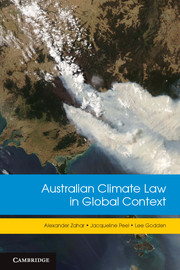Book contents
- Frontmatter
- Contents
- Acknowledgments
- Abbreviations and definitions
- Figures, tables and boxes
- Table of cases
- Table of statutes
- Table of treaties and other international instruments
- Introduction
- 1 Climate law
- 2 Legal elements and ongoing development of the international climate change regime
- 3 Measurement and verification of state emissions and legacy of the Kyoto Protocol’s compliance system
- 4 Development of climate law in Australia
- 5 Putting a price on carbon
- 6 The regulatory network of the Clean Development Mechanism
- 7 The emerging scheme for the protection of forests in developing countries (REDD)
- 8 Climate finance, technology transfer and capacity-building for sustainable development
- 9 Legal and regulatory frameworks for transition to a low-carbon economy
- 10 Biosequestration and emission reduction regulation in the Australian land sector
- 11 Adaptation to climate change through legal frameworks
- Postscript
- Bibliography
- Index
Introduction
Arguments, themes and overview
Published online by Cambridge University Press: 05 December 2012
- Frontmatter
- Contents
- Acknowledgments
- Abbreviations and definitions
- Figures, tables and boxes
- Table of cases
- Table of statutes
- Table of treaties and other international instruments
- Introduction
- 1 Climate law
- 2 Legal elements and ongoing development of the international climate change regime
- 3 Measurement and verification of state emissions and legacy of the Kyoto Protocol’s compliance system
- 4 Development of climate law in Australia
- 5 Putting a price on carbon
- 6 The regulatory network of the Clean Development Mechanism
- 7 The emerging scheme for the protection of forests in developing countries (REDD)
- 8 Climate finance, technology transfer and capacity-building for sustainable development
- 9 Legal and regulatory frameworks for transition to a low-carbon economy
- 10 Biosequestration and emission reduction regulation in the Australian land sector
- 11 Adaptation to climate change through legal frameworks
- Postscript
- Bibliography
- Index
Summary
Introduction
Climate change is a global problem touching all nations, yet one that manifests itself in innumerable local forms that have their own immediacy in the domestic context. Any legal analysis of the response to climate change must, therefore, encompass multiple dimensions. Accordingly, this book is addressed to an Australian as well as an international audience. We have attempted to explain and contextualise Australia’s regulatory responses to the problem of climate change within the global regulatory currents, analysing its domestic response as a case study in the international one. It is a premise of this book that in order to understand Australia’s actions, it is necessary to highlight the salient international pressures and governance models affecting its decisions. In the course of doing so, the book also refines our understanding of the international climate change regime.
The regulation of climate change is an international responsibility. As we argue in Chapter 1, it is necessarily international. Nevertheless, we recognise that ‘top-down’ international rule-making is complemented by ‘bottom-up’ national and regional contributions to the shaping of legal concepts in the field. The steps that Australia is taking to introduce a framework for climate change regulation may have broader significance, as a model for legal developments elsewhere. The country responds to international regulation, but its own measures may also reverberate outwards and upwards. This dynamic makes the book a contribution to international climate law studies, with Australia serving as a recurrent illustration from the sphere of practical application.
- Type
- Chapter
- Information
- Australian Climate Law in Global Context , pp. 1 - 11Publisher: Cambridge University PressPrint publication year: 2012

